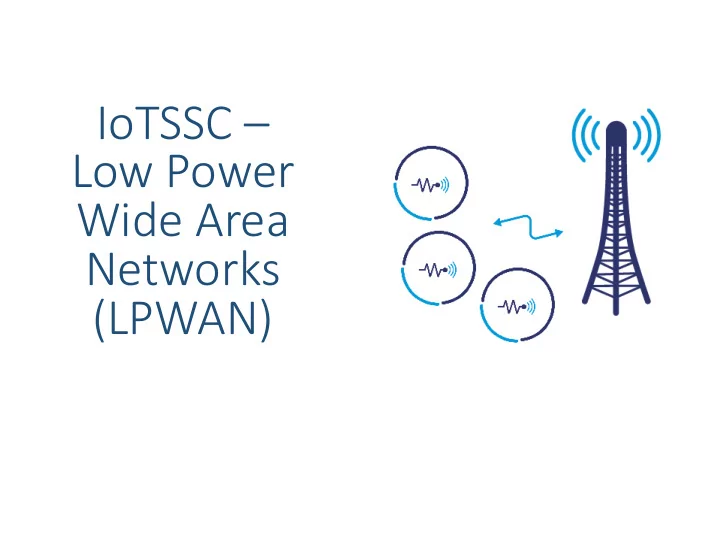

IoTSSC – Low Power Wide Area Networks (LPWAN)
LPWAN • Specifically targeting IoT applications • Battery powered devices
LPWAN • Coverage (lower frequency) vs bandwidth/throughput (WLAN/ WPAN)? • Licensed vs unlicensed spectrum? • Centralised vs decentralized access? • Compatibility with cellular systems? • Mobility support? • Latency constraints? • Security
LoRaWAN • One of the main contenders for LPWAN dominance • Operates in license-free ISM bands: 433, 868, 915 MHz • Regulated (power, duty-cycle, bandwidth) • EU: 0.1% or 1% per sub-band duty-cycle limitation • Protocol stack works on top of a chirp spread spectrum PHY layer (LoRa) – rates typically between 300bps – 5.5kbps + two ‘high speed’ (FSK) channels (11 and 50kb/s) • PHY is proprietary (SemTech) • Can work on 8 different frequencies at a time
LoRaWAN architecture
LoRa modulation • Chirp spread spectrum - Spread Factors (SF) 7 to 12 • Moving an RF tone through time linearly - breaking chirps in different places in terms of time and frequency to encode a symbol. Credits: Thomas Telkamp
LoRa modulation • Robust to interference • Symbol rate (SF bits per symbol) 𝑆 𝑡 = 𝐶𝑋 2 𝑇𝐺 • Bit rate 𝑆 𝑐 = 𝑇𝐺 𝐶𝑋 2 𝑇𝐺 • Data whitening, interleaving, FEC are then applied • FEC k/n – for every k bits of information n bits TX
LoRa bit rates vs SF (BW=125kHz) SF SF Ch Chir irps/symbol Bit Bitrate 7 128 5.469kb/s 8 256 3.125kb/s 9 512 1.758kb/s 10 1024 977b/s 11 2048 537b/s 12 4096 293b/s
LoRa bit rates vs SF (BW=125kHz) SF SF Ch Chir irps/symbol Bit Bitrate 7 128 5.469kb/s 8 256 3.125kb/s 9 512 1.758kb/s 10 1024 977b/s 11 2048 537b/s 12 4096 293b/s Numbers do not really match the formula. Why?
LoRa bit rates vs SF (BW=125kHz) SF SF Ch Chir irps/symbol Bit Bitrate 7 128 5.469kb/s 8 256 3.125kb/s 9 512 1.758kb/s 10 1024 977b/s 11 2048 537b/s 12 4096 293b/s Numbers do not really match the formula. Why? FEC is applied here as well. Can you guess the code rate?
LoRa bit rates vs SF (BW=125kHz) SF SF Ch Chir irps/symbol Bit Bitrate 7 128 5.469kb/s 8 256 3.125kb/s 9 512 1.758kb/s 10 1024 977b/s 11 2048 537b/s 12 4096 293b/s Numbers do not really match the formula. Why? Default code rate used is 4/5
LoRaWAN protocol stack
LoRaWAN device types Standard defines three classes of devices defined • Class A: Supported by all devices. Each uplink TX followed by two short downlink receive windows. • Class B: Extra receive windows at scheduled times latency controlled downlink); slotted communication • Class C: Continuously open receive widow, except when transmitting (mains powered devices, no latency)
LoRaWAN frame format
LoRaWAN security Two layers of security • Network Security Key (nwkSkey) – authenticates node in the network • Application Security Key (appSkey) – ensures network operator cannot inspect the data, but only service provider can • AES 128 used in both cases • MIC calculated over the ‘network’ part of the message – works as a signature
Device activation 1) Over The Air Activation (OTAA) • End-device follows a join procedure. (+) device can attach any LoRaWAN network, security keys can be updated on a per session basis; enables roaming (-) App server has to answer to join requests each time a device (re)starts, generating more downlink traffic.
Device activation 2) Activation By Personalization (ABP) • The end-device already pre-registered on the network. DevAddr and keys are stored in end-device and NS. (+) simpler from application server point of view (-) node tied to a particular network; vulnerable to replay attacks
UoE LoRaWAN infrastructure • Edge devices: Pycom dev boards (run micropython) • Gateways deployed @ library, Argyle House, Bush campus • TTN – The Things Network – open source NS stack https://www.thethingsnetwork.org
Narrow Band IoT (NB-IoT)
The NB-IoT paradigm • Standardised by 3GPP (Rel 13) to enable roll out over existing cellular infrastructure (focus on reliability) • Target apps: smart metering, smart cities (diagnostics and control), eHealth • Three types of deployments: *Wang et al. “A Primer on 3GPP Narrowband Internet of Things (NB -IoT )”
The NB-IoT paradigm • Bandwidth: 180kHz (low throughput) • Data rates: 25kb/s (downlink) and 64kb/s (uplink, multi-tone) • Latency <10ms • Hybrid ARQ scheme (reliability) • Power saving modes (base station can dictate power control through signalling)
Cellular IoT (CIoT) architecture (red) – control plane; (blue) – user plane RAN – Radio Access Network; S/P-GW – Serving/Packet Gateway MME – Mobility Management Entity SCEF - Service Capability Exposure Function (new addition)
Channel access - downlink • Each NB-IoT subframe spans one physical resource block (PRB) – 12 subcarriers • Narrowband Primary Synchronization Signal (NPSS); Secondary Synchronization Signal (NSSS); Physical Broadcast Channel (NPBCH); Reference Signal (NRS); Physical Downlink Control Channel (NPDCCH); Physical Downlink Shared Channel (NPDSCH)
Channel access - uplink • Narrowband Physical Random Access Channel (NPRACH) – similar to LTE, but narrower channel • Tone frequency index changes from one symbol group to another - single-tone frequency hopping
Questions?
Recommend
More recommend